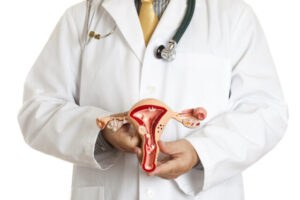
Uterine fibroids are non-cancerous growths that develop in or around the uterus. While many women don’t even know they have them, fibroids can significantly affect your daily life and well-being. Understanding their impact is key to knowing when to seek help and explore your treatment options.
Uterine Fibroids
Uterine fibroids, also known as leiomyomas, are benign tumors that form in the muscular wall of the uterus. They vary greatly in size, from microscopic growths to larger masses that can distort the uterus’s shape. Composed of smooth muscle cells and fibrous connective tissue, fibroids are non-cancerous and do not spread to other parts of the body. They are most common in women of reproductive age and are influenced by hormonal factors, particularly estrogen and progesterone. While not life-threatening, fibroids often cause symptoms such as heavy menstrual bleeding, pelvic pain, and discomfort, depending on their size and location.
Physical Symptoms
Fibroids can manifest a variety of physical symptoms, which may vary based on their size, number, and location within the uterus. Understanding these signs is necessary for early detection and effective management. Being aware of possible symptoms will help you make informed decisions about your care.
Excessive Menstrual Bleeding
Fibroids often cause changes in menstrual patterns. Excessive bleeding, known as menorrhagia, is one of the most common symptoms. It involves bleeding that is heavier or lasts longer than regular cycles. Women may have periods over seven days, bleeding between cycles, or need to change sanitary products hourly for several hours.
The increased blood loss from heavy bleeding can result in iron deficiency anemia, causing fatigue, weakness, and difficulty concentrating. The size and location of the fibroids influence bleeding patterns. Submucosal fibroids, which grow into the uterine cavity, are particularly likely to cause heavy bleeding, even when they are relatively small.
Pelvic Pain and Pressure
Fibroids typically cause various types of pelvic discomfort, including a feeling of fullness or pressure in your lower abdomen. This pressure might make you feel like you need to urinate frequently. You might also have pain, ranging from mild menstrual cramps to severe, sharp pains throughout your cycle. This pain can worsen with physical activity or sexual intercourse. Recognizing these symptoms is a key step in seeking appropriate care and finding relief.
Daily Impact
Large fibroids can press on your bladder, causing frequent urination or a constant urge to go. This pressure may reduce your bladder’s capacity or make emptying difficult, increasing your risk of urinary tract infections. It’s best to discuss any changes with your healthcare provider, especially as these symptoms often worsen.
Fibroids at the back of your uterus can press on the rectum, leading to constipation, bloating, or discomfort during bowel movements. This pressure can cause a feeling of incomplete emptying or abdominal distension. While dietary changes might offer some relief, addressing the fibroids directly is often key to lasting improvement.
Visit a Doctor Today
Recognizing fibroid symptoms is the first step in managing their impact on your health. Track your symptoms, noting their frequency, severity, and effect on daily life, as this helps guide treatment decisions. Treatment options range from medication for symptom management to surgery for more severe cases. Regular monitoring is a good practice, even for mild symptoms, since fibroids can grow and change over time. Early intervention often leads to better outcomes and help avoid complications requiring intensive treatment.





